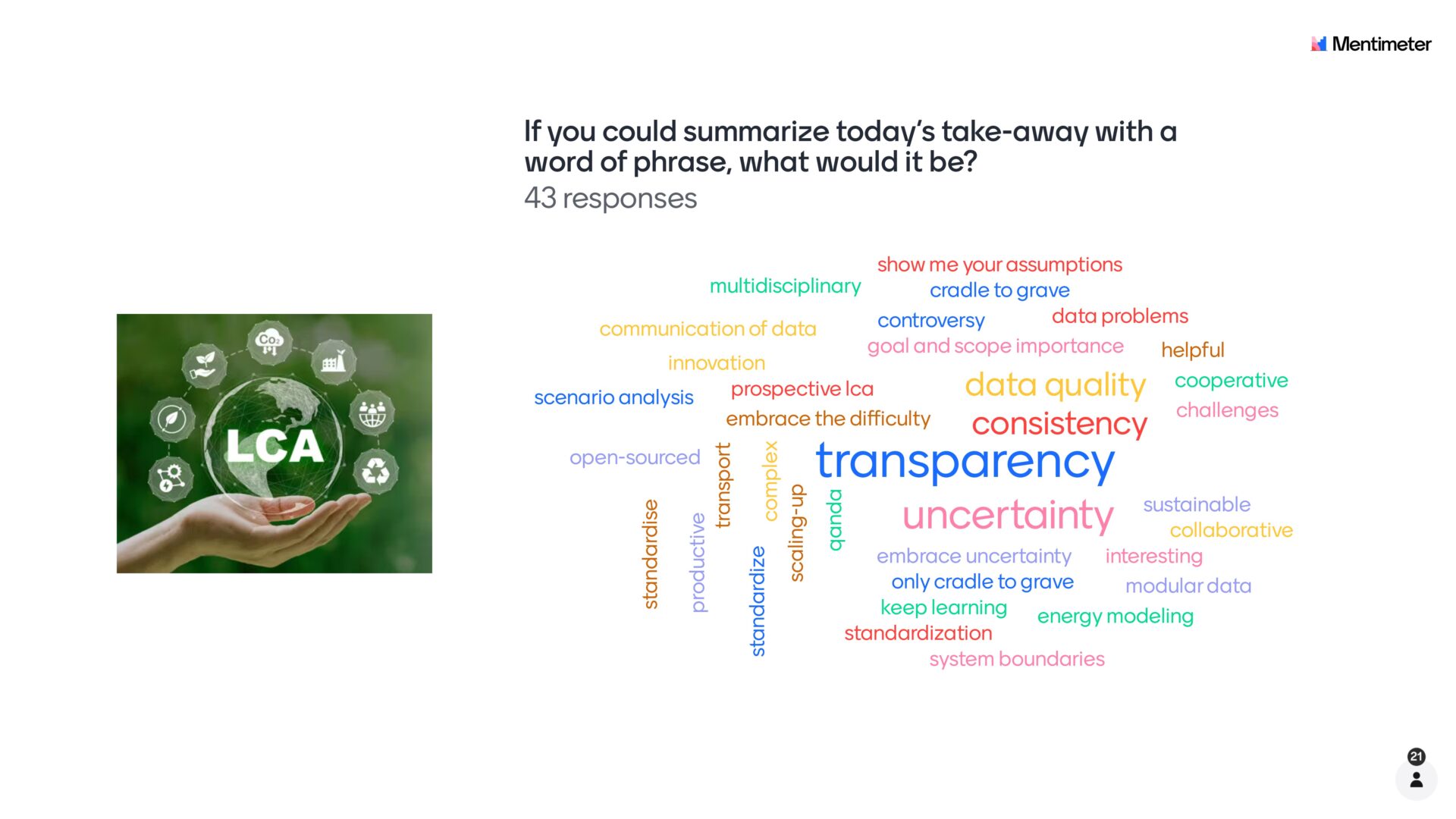Co-authors: Dirk Koppert (New Energy Coalition/ConsenCUS), David Yang Shu (ETH Zürich/ACCSESS), Ada Robinson (TU Wien/HiRECORD)
On Thursday 7th of March 2024, the EU Horizon 2020 projects ACCSESS and ConsenCUS co-hosted the second LCA to CCUS and alternative fuels workshop. Life cycle assessments (LCAs) are highly relevant for carbon capture and storage (CCS) and carbon capture and utilization (CCU) technologies, as we need to understand the potential of CCUS to contribute to EU climate strategies and goals.
The workshop was held online, with more than 100 attendees from different research institutes, universities, the European Climate, Infrastructure and Environment Executive Agency (CINEA), and the European Commission. Other EU-funded projects that participated in organizing the workshop were Photo2Fuel, LAURELIN, EcoFuel , CO₂Fokus , CO2SMOS, HiRECORD , Aurora , and C4U.
The event was opened by María Moragues Canovas, the programme coordination manager at CINEA. Mirko Busto (IN SRL) represented the organizers of the first LCA to CCUS and alternative fuels workshop, and gave a summary of its main outcomes. Keynote speeches were given by Nils Thonemann (Leiden University), Samantha Eleanor Tanzer (TU Delft) and André Bardow (ETH Zürich), who then engaged in a lively panel discussion wherein they highlighted the importance of transparency and consistency of LCAs, as well as considering different scenarios. After lunch, representatives from projects on alternative fuels and CCUS presented their work, as well as the main challenges not only for performing LCAs but also for sharing the results with non-LCA practitioners.

The future is hard to predict
The first keynote in this workshop was addressed by Assistant Professor Nils Thonemann from Leiden University. He addressed the difficulty of conducting an LCA in the early phase of an innovation project when little is known about its environmental impact. This is because you have to combine two worlds: that of the engineer/inventor/researcher (“yes, my prototype finally works, let’s see what we can do with it”) and that of the LCA practitioner (“how can I assess the impact with little information and unknown upscaling route”).
The ways an LCA can still benefit the innovation process was explained through the Collingridge Dilemma. The optimal development of emerging technology faces a double-bind problem: there is a lot of design freedom in the early stages, but little knowledge on the impact of this design. However, this does not mean that an LCA cannot be conducted. In fact, making use of a prospective method can help with gathering the necessary information for making decisions that can steer the next design steps. This can ultimately help to minimize the innovation’s impact on the environment. But there are challenges when conducting a prospective LCA. By addressing some of these challenges described below, Nils Thonemann guided the participants through the execution of a prospective LCA:
- Goal and scope: work on an honest scenario and comparability
- Life Cycle Inventory: work on your data scaling (foreground data) and build on your background data (what you are comparing your innovation to).
- Life Cycle Impact Assessment: characterization factor and adjustments.
- Most important: address the uncertainties when you make an Interpretation of the data you collect on the previous three topics.
The future is hard to predict, so it is important to understand that any single scenario will likely be wrong. Instead, focus on the value of developing multiple scenarios and an honest and transparent narrative. A prospective scenario requires a foreground system (development of the technology and its markets) and the surrounding technological system (background system – how will the wider economy develop?). The data collected through the various models (predictive, explorative, normative, building models) is put into the LCA. Consistency in the development of scenarios is key for a fair comparison.
Those interested in exploring these concepts further can find more details in Nils’ presentation slides.
Avoiding some of the common LCA pitfalls
In the second keynote, Assistant Professor Samantha Eleanor Tanzer from TU Delft talked about how to avoid some of the common pitfalls in LCAs, in particular with respect to being able to claim negative emissions.
- Follow the carbon from source to sink, and avoid cutting off the carbon source upstream of the investigated process, or cutting off the fate of the carbon downstream of the process. Processing CO2 captured from the atmosphere or a waste stream, or, if the carbon is produced directly for your system, the carbon extraction, processing and transport to site need to be included in the LCA. Not including the fate of the carbon downstream of your process in the system boundaries will distort the resulting climate impact of a system.
- Avoid claiming negative emissions without having done a cradle-to-grave LCA. Negative emissions require that the carbon needs to originate from the atmosphere (directly or via biomass) and that the carbon is stored out of the atmosphere in a manner intended to be permanent.
- Avoid adding up incommutable tons of CO2. There is an important distinction between CO2 emissions avoidance (CO2 in the atmosphere does not increase at a faster rate), CO2 emissions reduction (we emit less than in the past) and CO2 removals (CO2 is physically removed from the atmosphere). Do not add these types of CO2 together when presenting results.
- Avoid considering biomass as a carbon neutral feedstock by neglecting the process emissions associated with biomass supply.
The final main point of the keynote was the challenging but important topic of temporality and the importance of ensuring that temporal boundaries are well defined and aligned. This is crucial for data collection (be aware of the age of your data sets!), as time inconsistencies will impact the results of the LCA. There is a particular temporal aspect for biomass – CO2 captured and stored for a process using biomass is not removed from the atmosphere at that point in time, but over time as the biomass regrows.
Those interested in exploring these concepts further can find more details in Samantha’s presentation slides.
Taking a step back
The third keynote was held by André Bardow, professor at ETH Zürich, who addressed three important LCA challenges, namely:
- Handling different scenarios of energy mix,
- Relevance of the functional unit, and
- Lack of data and data estimation methods.
Assumptions on factors such as the energy mix, hydrogen sources, CO₂ sources and boundaries have a strong impact on LCA results and CO₂ footprint. This can also affect how trustworthy the results are. To tackle these inconsistencies, André reminded the audience that there are guidelines for conducting techno-economic analyses (TEAs) and LCAs on CCU processes, and that there is a DIN (German national institute for standardization) specification in process: the DIN SPEC 91508, Requirements for the Life Cycle Analysis of CCU and CCS Technologies. These guidelines have also proposed to use standardized scenarios for the energy mix.
André also showed how the impact of electricity on the estimated CO₂ footprint can be illustrated graphically, and emphasized the importance of being transparent with respect to sensitivities and reference scenarios. These graphical representations also make it possible to visualize if a process is carbon increasing, carbon reducing or carbon negative. In this regard, he invited the audience to extend cradle-to-gate analyses of CCU-based chemicals by assuming complete combustion, following precautionary principles.
Co-products are the norm in the chemical industry, which means multifunctionality must be taken into account through system expansion, including the full system and looking at all products simultaneously. This means that the functional unit for the CCU system might contain additional non-CCU products. André acknowledged that this approach can be “complicated”, but it is nevertheless necessary. He also explained how the avoided-burden approach might lead to misleading negative emissions.
André also invited the audience to take a step back: When defining the functional unit, we should ask ourselves what the function is that the investigated system is actually providing to society, if there are alternatives to this function, and if this function will be needed in the future.
Finally, to handle early-stage technologies, he argued that the guidelines should include methods for early technology readiness level (TRL) assessment. He also pointed out that there are LCA tools that can predict environmental impacts by, for example, using machine learning. Moreover, environmental impacts are often dominated by reactants, meaning that it is possible to use a stoichiometry-based assessment, with default values for utilities and energy consumptions. For cases, when there is no existing data, he showed that using “best-case” scenarios and thermodynamic analysis can already yield valuable insights. As with any prediction method, there are uncertainties with these approaches, but the insights are starting points that act as the basis of uncertainty analyses.
Those interested in exploring these concepts further can find more details in Andre’s presentation.
Identified common LCA questions and challenges in European projects on CCUS and alternative fuels
Three open questions
Although the European projects involved in LCAs of CCUS systems assess diverse processes, several common questions arose in the presentations and discussions.
Various projects encountered challenges in ensuring a fair comparison between researched CO2-derived products and CCS supply chains of different conventional counterparts. Even when the CO2-derived product is chemically identical to the conventional product, ensuring a fair comparison can be challenging. This difficulty arises from either a lack or an overabundance of literature benchmarks , worsened by inconsistent assumptions and methodologies.
Furthermore, some LCA practitioners from the European projects discussed ways to increase the usefulness of LCAs in decision-making. While LCAs provide valuable insights into the environmental performance of CCUS processes, predicting the market performance of CCUS processes remains challenging. Making these predictions requires multi-disciplinary insights that extend beyond environmental assessments into scalability, efficiency bottlenecks, and the integration of CCUS processes into transitioning industries. Anticipating the market performance of CCUS processes is particularly difficult at low technology readiness levels, where LCA practitioners need to make assumptions about the upscaling potential of the process and future markets.
Finally, moving beyond LCAs, workshop participants discussed the legislative support that might be required to bolster CCUS technologies. Insights from LCAs could guide the design of incentives from policymakers to ensure the sustainable transition of carbon-based industries.
Challenges to overcome
Modelling and assessing technologies at low TRLs result in high data uncertainty. Environmental assessments of such technologies are further complicated by the limited availability of literature and varying assumptions in existing studies. For processes relying on biomass, impact assessment methods such as Impact World+, ReCiPe, and Environmental Footprint differ in the accounting of biogenic carbon. To ensure transparency and comparability, a convergence in the foundational assumptions and methodologies is required.
In addition to the harmonization of LCAs, an in-depth understanding of CCUS processes and life-cycle impact assessment (LCIAs) methodologies is essential for enabling environmental assessments that are tailored to the specific process. In-depth methodological understanding is particularly important when applying prospective LCAs that encompass changes in the background data over time, i.e., changes in the electricity mix, technological advancements, market dynamics, and crop yields.
Read more: Overview of EU projects on CCUS represented at the second LCA for CCUS & alternative fuels workshop
Main takeaways
At the end of the workshop, participants shared their main takeaways:

Both LCA and CCUS are evolving disciplines. CCUS is scaling up, and each project and application has its own peculiarities. It is therefore challenging to foresee all the potential variations and requirements for the LCA of CCUS processes, but this difficulty should be embraced.
LCAs have become a helpful and popular tool beyond the specialists’ community. It is highly multidisciplinary and collaborative, and its results are also used by non-practitioners, which makes accurate communication essential. It was also clear throughout the workshop that LCAs must be transparent. Well-defined and communicated system boundaries, from cradle to grave, will provide a clearer picture of actual potentials for CO₂ avoidance and carbon removals.
Assumptions will need to be made, and there will be variations with respect to the quality, sources, and availability of data. To tackle this uncertainty, scenario analyses and prospective LCAs are core tools. Moreover, the growth in LCA studies will facilitate the reuse of data, which will be aided by standardization and modularization procedures.
Recommended Methods, Data, and Tools
In this section, we have collected assessment methods, databases, and tools applied in European projects that conduct LCAs for CCUS.
Life-cycle impact assessment methods: ReCiPe 2016, Environmental Footprint 3.0, IMPACT World+
Databases: ecoinvent, CarbonMinds, PSILCA
Tools: Brightway2 with the user interface Activity Browser, SimaPro, GaBi for LCAs; premise for prospective assessments










Comments
Excellent resume of the LCA .